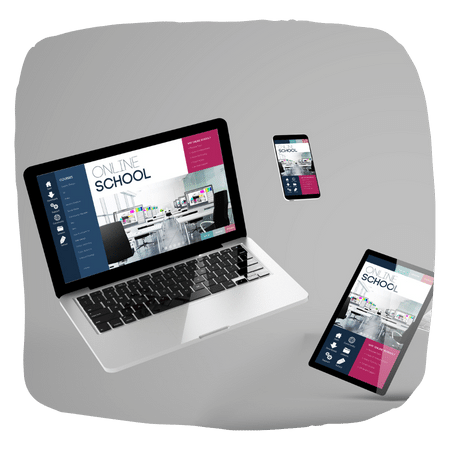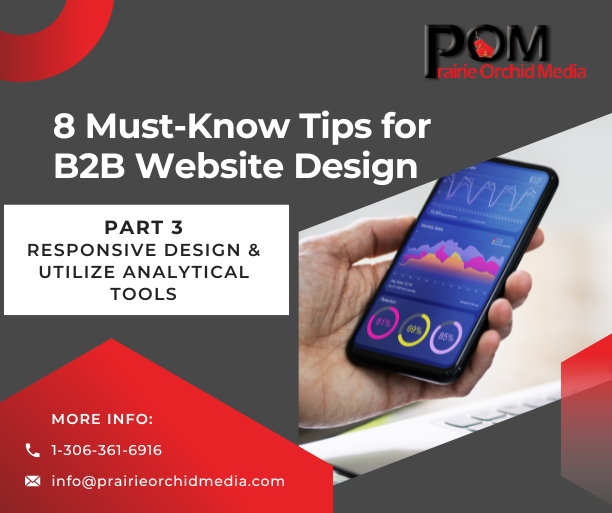We're back on part three of the 8 Most Important Guidelines for Designing B2B Websites - let's dive in! So far we've gone over what a B2B website is and how you absolutely must understand your customers. You should also make sure to optimize the navigation as well as focus on your content strategy. Lastly, throw some SEO techniques into the mix for maximum reach. Recap-time: a B2B website is one that caters to companies instead of consumers, stay focused on those objectives when building yours! Did you miss our last blogs? Don't sweat it - just head back and read up!
This week we're gonna chat about why responsive website design is a must-have, and how you can utilize analytical tools to get the most out of your website. You need to stay up-to-date in the digital age with a snazzy site that looks great on any screen - plus, if you do it right your visibility will skyrocket in search results! Analytics help you figure out exactly what your customers want so your website is their go-to destination every time. 97% of consumers use the internet to research products before they buy, so make sure you're giving your customers a reason to choose you!
Tip #5: Make Responsive Design a Priority
Responsive website design is no longer an option but a necessity for modern websites. With mobile devices accounting for over half of all internet traffic, it's essential that your B2B website adapts to different screen sizes and resolutions. Responsive design ensures that your website looks great and functions smoothly on any device, whether it's a desktop computer, a tablet or a smartphone.
 One of the key benefits of responsive design is that it provides users with a seamless experience across different devices. When a user accesses your site from their phone or tablet, they won't have to pinch and zoom to read content or navigate through the pages. Instead, they will be able to interact with your site in much the same way as they would on a desktop computer.
One of the key benefits of responsive design is that it provides users with a seamless experience across different devices. When a user accesses your site from their phone or tablet, they won't have to pinch and zoom to read content or navigate through the pages. Instead, they will be able to interact with your site in much the same way as they would on a desktop computer.
Another advantage of responsive design is that it helps improve search engine rankings. Google now considers mobile-friendliness as one of its ranking factors, so having a responsive website can help boost your visibility in search results pages. This means more traffic to your site and ultimately more leads and conversions for your business.
Responsive Design Affects SEO
A website that is not responsive can have a negative impact on search engine rankings. Google's algorithm considers mobile-friendliness as one of the ranking factors, so having a mobile-friendly website has become essential for SEO. Responsive design ensures that the website is optimized for different devices and screen sizes, making it easier for search engines to crawl and index the pages.
With responsive design, there is only one URL for both desktop and mobile versions of a website. This means that all traffic goes to the same page instead of being split between two different URLs. As a result, responsive websites are more likely to get higher search engine rankings than non-responsive ones.
Moreover, responsive design also helps in reducing bounce rates which improves the user engagement metric that Google uses in its ranking algorithm. A well-structured and easy-to-navigate website with fast load times can provide an exceptional user experience across all devices, encouraging users to stay longer on your site. This leads to more engagement with your content and higher chances of conversion opportunities - further strengthening your SEO performance.
Get ahead and make sure your website looks great on all devices! Unlock even more opportunities with our previously-published blog article - Unlock Opportunities With a Mobile Compatible Website.
Tip #6: Utilize Analytical Tools
 One of the essential aspects of B2B website design is to utilize analytical tools effectively. Analytical tools will help you track your website's performance, analyze user behavior, and understand how visitors interact with your site. By using these tools, you can identify what works best for your audience and optimize accordingly.
One of the essential aspects of B2B website design is to utilize analytical tools effectively. Analytical tools will help you track your website's performance, analyze user behavior, and understand how visitors interact with your site. By using these tools, you can identify what works best for your audience and optimize accordingly.
Google Analytics is one of the most popular web analytics services available today that provides comprehensive insights into website traffic and visitor behavior. It helps track metrics such as page views, session duration, bounce rate, conversion rates and other relevant data points that help businesses make informed decisions about their website's design.
Page Views and Duration
As a B2B company, your website is the face of your brand, and it's crucial to understand how users interact with it. Google Analytics provides valuable insights into website traffic that can help you optimize web design and content for better user experience. With Google Analytics, you can track visitor behavior, such as where they come from, what pages they visit most frequently, and how long they stay on each page. You can even set up e-commerce tracking to see how many site visitors make a purchase. This data is useful for identifying the most popular pages on your website, as well as the least popular pages that need redesign or updating.
When it comes to B2B website design, tracking your analytics page views and duration is essential. By monitoring these metrics, you can gain a better understanding of how users are interacting with your website and identify opportunities for improvement.
Page views refer to the number of times a specific page on your website has been viewed by visitors. This metric is useful because it allows you to determine which pages are receiving the most traffic and which ones might need some attention. Duration, on the other hand, refers to how long visitors spend on each page. This metric can help you determine whether visitors are engaging with your content or simply scrolling past it.
Analyzing both page views and duration together can give you a better idea of how users are navigating through your site. For example, if one particular page receives a lot of traffic but has a short duration time, it may indicate that users aren't finding what they're looking for on that page. Understanding these metrics can help you make informed decisions about changes to your website design or content strategy that will ultimately lead to better engagement and more conversions.
One key metric to track in Google Analytics is bounce rate - the percentage of visitors who leave your site after only viewing one page. A high bounce rate may indicate that your landing pages aren't compelling enough, or that users are having trouble finding what they're looking for. Other important metrics include time spent on page, click-through rates on CTAs (calls-to-action), and conversion rates on lead generation forms.
Web design and content are critical components of a website’s user experience. A well-designed website with quality content not only attracts visitors but also keeps them engaged, resulting in lower bounce rates and higher conversion rates. Google Analytics is an essential tool for tracking visitor behavior on your website. By analyzing data such as where visitors come from, what pages they visit, how long they stay on the site, and what actions they take (such as filling out a form or making a purchase), you can make informed decisions about your web design and content.
 Bounce Rate and Conversion Rate
Bounce Rate and Conversion Rate
Google Analytics also allows you to monitor metrics such as bounce rate and conversion rate. By tracking these metrics regularly, you can identify areas of improvement to increase engagement and conversions. Additionally, Google Analytics has an e-commerce tracking feature that enables businesses to track their online sales performance accurately.
The bounce rate indicates how many visitors leave your site after viewing only one page. A high bounce rate can indicate that your website is not engaging enough or that it is not relevant to the visitor's needs. On the other hand, a low bounce rate means that visitors are finding value in your website and are taking the time to explore multiple pages.
Conversion rate, on the other hand, measures how many visitors complete a desired action, such as filling out a contact form or making a purchase. By monitoring this metric regularly, you can identify which pages or elements of your website are contributing to higher conversion rates and optimize them for even better results. Additionally, tracking these metrics over time can help you identify trends in user behavior and make informed decisions about future updates to your website design and content strategy.
Overall, using Google Analytics is essential for any B2B business looking to improve its website performance. It's a powerful tool that provides detailed insights into user behavior and site activity while helping companies optimize their websites for better user engagement and conversions.
B2B website design requires a deep understanding of your target audience to create effective and engaging web experiences. A strategic approach that considers all aspects of design, including visual appeal, functionality, usability, and content is crucial. By following the eight tips outlined in this series, you can create a website that not only meets but exceeds the expectations of your potential customers.
By implementing these strategies into your B2B website design process, you'll be able to attract more leads, engage with them effectively and ultimately drive conversions for your business.
Don't miss out on the fun next week when we'll uncover our last 2 awesome tips - it'll be amazing!
Thanks for being part of the Prairie Orchid Media community, and we look forward to helping you reach your website goals this year. We offer a wide range of web development and design services to help businesses increase their web presence.



